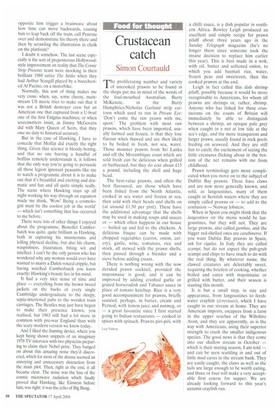Crustacean catch
Simon Courtauld
Theproliferating number and variety of uncooked prawns to be found in the shops put me in mind of the words of the foul-mouthed Australian, Barry McKenzie, in the Barry Humphries/Nicholas Garland strip cartoon which used to run in Private Eye: 'Don't come the raw prawn with me, sport.' The problem with most raw prawns, which have been imported, usually farmed and frozen, is that they lose flavour when thawed and are then likely to be boiled in fresh, not sea, water. Those monster prawns from Sri Lanka and off the Mozambique coast which are sold fresh can be delicious when grilled or barbecued, but they do cost about £15 a pound, including the shell and huge head.
The best-value prawns, and often the best flavoured, are those which have been fished from the North Atlantic, cooked in sea water and frozen at sea, then sold with their heads and shells on (at around £1.50 per pint). These have the additional advantage that the shells may be used in making soups and sauces or — which often happens in our house — boiled up and fed to the chickens. A delicious bisque can be made with chopped vegetables (carrot, onion, celery), garlic, wine, tomatoes, rice and stock, all stewed with the prawn shells, then passed through a blender and a sieve before adding cream.
There is nothing wrong with the now derided prawn cocktail, provided the mayonnaise is good; and it can be improved by adding crushed garlic or grated horseradish and Tabasco sauce in place of tomato ketchup. Rice is a very good accompaniment for prawns, briefly sautéed, perhaps, in butter, cream and Pernod, with lemon juice and nutmeg, or —a great favourite since I first started going to Indian restaurants — cooked in spices with spinach. Prawns pin-pin, with a chilli sauce, is a dish popular in southern Africa. Rowley Leigh produced an excellent and simple recipe for prawn pilaff about three years ago in the Sunday Telegraph magazine (he's no longer there since someone took the insane decision to replace him earlier this year). This is best made in a wok, with oil, butter and softened onion, to which you add basmati rice, water, frozen peas and sweetcorn, then the cooked prawns at the end.
Leigh in fact called this dish shrimp pilaff, possibly because it would be more recognisable to Americans, for whom all prawns are shrimps or, rather, shrimp. Anyone who has fished for these crustaceans on the coasts of Britain will immediately be able to distinguish between a shrimp, an opaque pale grey when caught in a net at low tide at the sea's edge, and the more transparent and larger prawn, usually found in rock pools feeding on seaweed. And they are still fun to catch; the excitement of seeing the little creatures flicking about in the bottom of the net remains with me from childhood.
Prawn terminology gets more complicated when you move on to the subject of Dublin Bay prawns. These have claws and are now more generally known, and sold, as langoustines, many of them caught in Scottish waters where they are simply called prawns or — to add to the confusion — Norway lobsters.
When in Spain you might think that the langostinos on the menu would be langoustines, but they will not. They are large prawns, also called gambas, and the bigger red-shelled ones are carabineros. If you want Dublin Bay prawns in Spain, ask for cigalas. In Italy they are called scampi, but do not expect the pub-grub scampi and chips to have much to do with the real thing. By whatever name, the clawed creatures are delectably sweet, requiring the briefest of cooking, whether boiled and eaten with mayonnaise or grilled with butter, and their season is starting this month.
It is but a small step, in size and appearance, from langoustines to freshwater crayfish (ecrevisses), which I have caught in our stream at home. They are American imports, escapees from a farm in the upper reaches of the Wiltshire Avon, and they are apparently, as is the way with Americans, using their superior strength to crush the smaller indigenous species. The good news is that they come into our shallow stream in October — which is their mating season, I am told — and can be seen scuttling in and out of little mud caves in the stream bank. They are easily caught, the claws as well as the tails are large enough to be worth eating, and three or four will make a very acceptable first course for supper. We are already looking forward to this year's autumn crayfish run.


































































 Previous page
Previous page